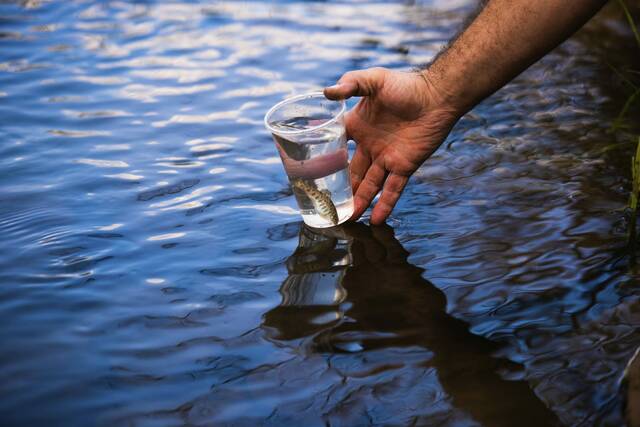https://development.triblive.com/local/westmoreland/trout-raising-program-at-hempfield-area-brings-conservation-to-the-classroom/
Trout-raising program at Hempfield Area brings conservation to the classroom

From the moment Hempfield Area junior Hayden Simmons heard about her science class’s trout project, she knew she wanted to get involved.
“He said we were getting fish, and I was like, ‘When can I start?’ ” she said. “I just wanted to help.”
Each morning during homeroom, and each afternoon in class, Simmons has headed to Hempfield Area High School teacher Tim Turner’s classroom. She’s tested the water chemistry, changed the water and fed the approximately 40 trout that lived in a tank in Turner’s classroom.
Simmons and other members of Turner’s class worked together to raise the fish from hatchlings, through the Trout in the Classroom program, sponsored by the Pennsylvania Fish and Boat Commission and the nonprofit Trout Unlimited.
Last week, Simmons and her classmates got to see their project to completion when they released the fruit of their efforts into the waters of the Loyalhanna Creek. Students scooped up the fish in clear plastic cups and set them free at a stream spot in Ligonier Township.
“I’ve been super excited, counting down the days. I’m definitely going to miss them, but they’re getting a lot of work, they needed to go. They’re ready,” she said. “I think I learned a lot about conservation and the animal itself.”
Teaching trout
The Trout in the Classroom environmental education program teaches students about the habitats, conservation initiatives and life cycles that make it possible for trout to live in the wild, through a hands-on trout-raising program and connected lessons.
“It’s for the kids to see the life cycle and the development, and to discuss cold water conservation, while getting kids interested in fishing and trout,” Turner said.
This year is Turner’s first year managing the program, and the first year it’s been at the high school. Previously, elementary art teacher Matt Clark ran the program, but he handed it over to Turner this year.
The Trout in the Classroom program at the elementary level, Clark said, was initially made possible through a First Energy STEM classroom grant and a Hempfield Foundations grant.
“There is a decent cost in starting up the program, acquiring the needed equipment, but after that, PA Fish and Boat supply the eggs and food, and some minimal wear and tear items (that) need replenishing,” Clark said.
Conserving ecosystems
Larry Myers, president of the Forbes Trail chapter of Trout Unlimited, says the program helps expose the next generation to conservation and interaction with area bodies of water.
“It teaches them about cold water conservation, ecology, the need to protect our trout streams,” he said. “We teach fly fishing, but what we’re trying to do most of all is recruit and train the next future of cold-water conservationists. That’s why we like working within the schools.”
The program can help catch the attention of students and make conservation more “real” to them, he explained.
“They can actually help with the maintenance of the tank and the feeding of the fish, they get to see it grow and they develop an appreciation for how delicate a fish’s life is,” he said. “If it’s hard to raise them in a tank, you can only imagine how difficult it would be out in a stream.”
Conservation is a big deal for trout because the fish have an optimal temperature to live, Turner explained.
“Their optimal temperature is between 50 and 68 degrees. If water temperatures go above 68 degrees, they start to stress,” Turner said. “Normally, our environment is full of trees that shade our streams and things like that, but as more and more development occurs, and you lose streamside vegetation, and more parking lots come into effect, all that runoff creates warm water, and increases the temperature, that makes it hard for trout to survive.”
For students who may not have grown up with families who are interested in hunting and fishing, the program can also be an introduction to a new world, he explained.
“It allows them to experience something that they don’t normally get to see. Especially nowadays, a lot of kids don’t get access to see resources like this up close and personal,” Turner said.
Environmental education
Students were eager to participate in the fish release on Wednesday. Brock Maloney, a Hempfield senior, clambered on the rocks to release fish into the stream. An environmental science buff, Maloney is planning to attend Penn State University to study wildlife and fisheries.
“It’s awesome to have a teacher like this, to have an opportunity like this,” he said. “Most kids don’t get that, and I’m lucky that I’ve got something like this in my school.”
At the high school, preschoolers from the district’s Little Spartans program got to meet the fish, which senior Cheyenne Fanala said was a highlight.
“I got to show them the babies, and I got to let them feed them. They really loved seeing the fish — it was an awesome experience to watch,” she said.
Fanala said she has “a bunch of great memories” of her time catching trout with her family as a kid. She’s heartened by the thought that someone else might catch the fish she helped to raise and make their own memories.
“It’s happy and sad,” she said. “It’s sad to see them go, but it’s really cool to see them and know they are going into their natural habitat.”
Copyright ©2025— Trib Total Media, LLC (TribLIVE.com)
